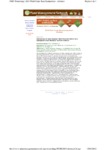Please use this identifier to cite or link to this item:
http://www.alice.cnptia.embrapa.br/alice/handle/doc/919008| Title: | Comparison of asian soybean rust chemical control on a susceptible and a resistant cultivar in Brazil. |
| Authors: | VENANCIO, W. S.  VENANCIO, R. M.   MEYER, M. C.   NUNES JUNIOR, J.   BEGLIOMINI, E.   JASPER, M.   |
| Affiliation: | W. S. VENANCIO, EEACG/UEPG, Ponta Grossa, PR, Brazil R. M. VENANCIO, CESCAGE - Ponta Grossa, PR MAURICIO CONRADO MEYER, CNPSO J. NUNES JUNIOR, CTPA - Goiânia, GO. E. BEGLIOMINI, BASF, Singapura. M. JASPER, CESCAGE - Ponta Grossa, PR. |
| Date Issued: | 2011 |
| Citation: | In: PLANT MANAGEMENT NETWORK; FIELD CROPS RUST SYMPOSIUM, San Antonio, 2011. Proceedings ... Saint Paul: APS: ASA: CSSA: 2011. Abstract, 24. Disponível em: < http://www.plantmanagementnetwork.org/proceedings/FCRS/2011/posters/>. |
| Description: | The development of resistant cultivars to the Asian soybean rust (ASR), caused by Phakopsora pachyrhizi, brought an additional tool to the disease management in Brazil. ASR develops slower in resistant cultivars than in susceptible ones, allowing a reduction of the number of fungicide sprays, but chemical control is still necessary. A field trial was conducted in Ponta Grossa, Parana State, in order to compare the effects of ASR chemical control with four fungicide formulations, in both resistant (BRSGO 7560) and susceptible (CD 249 RR) soybean cultivars. The fungicides were applied twice, beginning at soybean growth stage R3?R4, when first uredinia were observed, and at soybean stage R5.3?R5.4. The fungicides used were premix formulations of pyraclostrobin + epoxiconazole + fluxapyroxad (40+64.8+40 g a.i./ha), azoxystrobin + cyproconazole (60+24 g a.i./ha), pyraclostrobin + epoxiconazole (79.8+30 g a.i./ha), and epoxiconazole (125 g a.i./ha). The ASR severity at soybean growth stage R7 on nonsprayed plots reached 75.4% on the resistant cultivar and 98.6% on the susceptible cultivar. Lower ASR severity index were observed in the resistant cultivar, with the treatments pyraclostrobin + epoxiconazole (9.8%), pyraclostrobin + epoxiconazole + fluxapyroxad (10.5%), and azoxystrobin + cyproconazole (10.9%), with an average of disease control ranging from 90.8 to 91.3%. The treatments with pyraclostrobin + epoxiconazole and pyraclostrobin + epoxiconazole + fluxapyroxad provided the lower yield reductions on both soybean cultivars. The yield and grain weight reductions in the nonsprayed treatment were 32 and 28%, respectively, on the resistant cultivar and 44 and 32%, respectively, on the susceptible cultivar. |
| Thesagro: | Soja Doença de planta Ferrugem Doença fúngica Phakopsora Pachyrhizi |
| NAL Thesaurus: | Soybeans Plant diseases and disorders |
| Type of Material: | Resumo em anais e proceedings |
| Access: | openAccess |
| Appears in Collections: | Resumo em anais de congresso (CNPSO)  |
Files in This Item:
| File | Description | Size | Format | |
|---|---|---|---|---|
| comparison.fielcropssymposium.2011.pdf | 37.2 kB | Adobe PDF |  View/Open |









